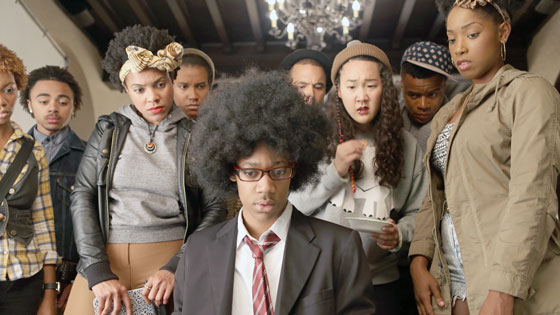Dear White People
At the end of Dear White People, I shrugged. Watching the film was a fun and enjoyable experience but it didn’t leave a valuable, lasting impact. Dear White People doesn’t add anything to the conversation on race; it just has fun playing with it.
The film tells the story of black culture and racial tension on the campus of a fictionalized, mostly white and prestigious university. Racial drama ensues as a black power movement arises. The film follows the movement, its main players, the predominantly white establishment of the university, and the shifting identities of everyone involved.
Dear White People overtly puts itself in the shadow of classic African-American cinema with similar themes and direct mentions of Spike Lee or his films three different times (by my count). While it feels like the film accurately shows what writer/director Simien’s characters would be thinking about, it also puts his film in the shadow of greater works like Do the Right Thing (racial tension) and Bamboozled (white people offensively imitating black culture). Lee captures the intense emotion of these situations while Simien mostly succeeds when playing for laughs. It’s not that he isn’t a deeply intelligent filmmaker but that I’m not sure what the point of this whole exercise was. I think I would’ve preferred a double feature of the Lee movies mentioned above (an amazing way to spend four hours I might add).
Part of the failure of Dear White People is that it relies too much on caricature. It doesn’t caricature specific characters, as all of these characters resemble real people, but that it caricatures of the broader structure of racial tension and separation in our society or specifically within modern American colleges. Outside of the African-American community, only realistic stereotypes exist. Even within the African-American community, the main characters all represent polarities (which I won’t describe, as the film does so quite well and humorously). Dear White People needs more nuanced representations of people that bleed into the center of the racial identity spectrum. To be clear, these people don’t need to be the focus but exist in order to ground the reality of the focal character’s actions.
Some of Simien’s characters are fantastic. The leader of the black culture movement on campus is Sam White (Tessa Thompson), an intelligent, complex and relatable human being struggling with her many shifting identities. Also intriguing and underutilized is Lionel (Tyler James Williams), an outcast who doesn’t quite fit in to any of the racial groupings. His homosexuality becomes prominent in a climactic scene, which is by far the most fascinating and provocative, but which I must remain oblique on because it would be a spoiler.
I wouldn’t say don’t see this film, because it’s a very good film, but not until you’ve already seen Do the Right Thing and Bamboozled.
Grade: B
The Sacrament
The Sacrament is the type of horror fiction that is only worthwhile for a handful of scenes. It begins with a minor variation on the irritatingly boring found-footage method. A reporter from Vice Magazine receives contact from his lost sister who is living in a hippie cult. She invites him over to visit her there. He agrees to come and brings some of his fellow reporters to document the trip and make a segment about the cult.
As they arrive and enter the supposedly peaceful commune, they are met by men with machine guns. Surprise, surprise, it’s not what they thought it would be! Creepy children, a dangerously delusional religious figure, brainwashed followers and prominent crosses bring much of the usual taste from modern horror cinema. The Sacrament brings nothing new to the table, other than some great acting by the religious leader and cool cinematography. Overall, the found-footage aspect is extremely unrealistic, opting for nice shots rather than logical character choices. I can’t understand why they didn’t just do the film without shaky cam. Clearly, this film is standard-issue for horror.
The subject matter was kind of fun, if you find cults intriguing, which I do. The cinematography looked great. Maybe just turn off your brain, because this is not a movie that you want to think about or you’ll realize how few moments are actually even remotely plausible.
Grade: C+


 RSS Feed
RSS Feed
